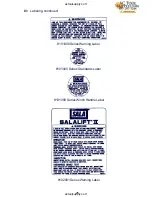
10
3.2 PLANNING: Plan your system and how it will function before starting
your work. Consider all factors that affect your safety during use. Some
important points to consider when planning your system are:
A. HAZARD EVALUATION: Evaluate job site hazards prior to starting
work. Consult applicable OSHA and industry standards for
guidelines and regulatory requirements on issues such as confined
space entry, personal fall arrest systems (PFAS), and single point
adjustable suspended scaffolds.
B. WORK SITE GEOMETRY: The installation and use of the support
structure (tripod, davit arm and base) must be consistent with the
geometric requirements stated in the associated manufacturer's
instruction manuals. When suspending working lines from the
support structure, check for obstructions or sharp edges in the work
path. Avoid working where the user may swing and hit an object, or
where lines may cross or tangle with that of another worker.
C. SECONDARY OR BACK-UP FALL ARREST SYSTEM: When using
the Salalift winch (8101000 series) as a support for work positioning,
a secondary or back-up fall arrest system is required. See OSHA 29
CFR 1910.28 and 1926.451. The DBI/SALA tripod and davit arm has
provisions for connection of a secondary or back-up PFAS. See
sections 3.3 and 3.5 (A).
D. RESCUE: A means of dealing with an accident or emergency must
be planned in advance. Response time can play an important role in
the survival of an injured worker. Users of this equipment must be
trained in emergency procedures.
3.3 REQUIREMENTS FOR PERSONAL FALL ARREST SYSTEMS: PFAS
used with the Salalift or Salalift II winch and support structure must
meet applicable OSHA requirements.
• The PFAS should be rigged to minimize any potential free fall and
never allow a free fall greater than 6 feet. It is recommended that the
PFAS used with this equipment include a full body harness as the
body support component. PFAS's that incorporate full body
harnesses must maintain fall arrest forces below 1,800 lbs. and arrest
the fall within 42 inches. Body belts, unless incorporated into a full
body harness, are not recommended for use with this equipment. A
typical PFAS includes a full body harness, connecting subsystem or
component (self retracting lifeline or lifeline and rope grab), and the
necessary connectors to couple the system together.
• Anchorages selected for PFAS must sustain static loads, applied in
the directions permitted by the PFAS, of at least; (A) 3,600 lbs.
actoolsupply.com
actoolsupply.com











































